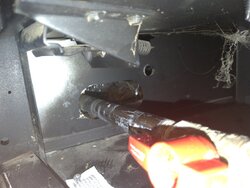My model is: SL-550TR-IPI-E
Ok, so while I have another thread open on resolving why it's not lighting, what can I do about the wind tunnel of Cold Air... OMG!
In looking to repair it, I've looked to see why it's so cold, it's like having a window open in your house all the time. The vent pipe is straight out the back to a protective cage on the outside of the house, however, there is no damper, just a straight pipe, so when the fireplace is not lit, cold air rushes into the house.
Also, when the gas black pipe comes in on the lower left, the knockout (large oval) is gone and only the pipe is there. What material can I to plug this as cold air just rushes into the house.
Any ideas..thanks
Ok, so while I have another thread open on resolving why it's not lighting, what can I do about the wind tunnel of Cold Air... OMG!
In looking to repair it, I've looked to see why it's so cold, it's like having a window open in your house all the time. The vent pipe is straight out the back to a protective cage on the outside of the house, however, there is no damper, just a straight pipe, so when the fireplace is not lit, cold air rushes into the house.
Also, when the gas black pipe comes in on the lower left, the knockout (large oval) is gone and only the pipe is there. What material can I to plug this as cold air just rushes into the house.
Any ideas..thanks


